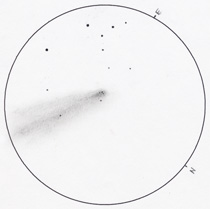 The sketch at left records a 109X view of Fragment C in the 18-inch Obsession. The comet is centered and features a stellar core region enveloped within a bright inner coma that teardrops to the southwest over a distance of 1'.5 to 2'. The brightest portion of the tail extends straight back toward the edge of the field and beyond; a distance of 22' and more. A broader, more subtle tails sweeps towards the same southwest field boundary and has a width of about 6' when 16' from the pseudonucleus. a Y-asterism of five stars is grouped 3' to the east. The brightest of these shine at 11th magnitude. Less than an arcminute northeast of the comet, a 13th magnitude GSC star is seen. Another sixteen stars dot the field. Occasionally, I catch a hint of more than one stellaring in the core of the comet. So, I paired an 18-mm Meade SWA eyepiece with a Tele Vue 3X Barlow for a high magnification view.
The sketch at left records a 109X view of Fragment C in the 18-inch Obsession. The comet is centered and features a stellar core region enveloped within a bright inner coma that teardrops to the southwest over a distance of 1'.5 to 2'. The brightest portion of the tail extends straight back toward the edge of the field and beyond; a distance of 22' and more. A broader, more subtle tails sweeps towards the same southwest field boundary and has a width of about 6' when 16' from the pseudonucleus. a Y-asterism of five stars is grouped 3' to the east. The brightest of these shine at 11th magnitude. Less than an arcminute northeast of the comet, a 13th magnitude GSC star is seen. Another sixteen stars dot the field. Occasionally, I catch a hint of more than one stellaring in the core of the comet. So, I paired an 18-mm Meade SWA eyepiece with a Tele Vue 3X Barlow for a high magnification view. |
 At 399X in the big Dob, the inner coma and core region come to life. Three point sources are seen within the coma and a fourth lies just outside to the west. At least one of the four is a star. According to VizieR, the point source just west of the coma is 2MASS 15245926+2607251, a 14.2(B) magnitude star at 15h 22m 51.0s, +26d 17m 56s. Presumably, one of the three stellarings in the coma is a pseudonucleus. The other two may be a pseudonuclei around other cometary fragments or, perhaps, averted imagination. Hopefully, the CCD imagers can help sort this one out.
At 399X in the big Dob, the inner coma and core region come to life. Three point sources are seen within the coma and a fourth lies just outside to the west. At least one of the four is a star. According to VizieR, the point source just west of the coma is 2MASS 15245926+2607251, a 14.2(B) magnitude star at 15h 22m 51.0s, +26d 17m 56s. Presumably, one of the three stellarings in the coma is a pseudonucleus. The other two may be a pseudonuclei around other cometary fragments or, perhaps, averted imagination. Hopefully, the CCD imagers can help sort this one out. |
![]()
![]()
